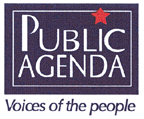Civic Journalism: Six Case Studies
TALLAHASSEE, FLA.
“The Public Agenda”
Now we take what has come to be known as public journalism or civic journalism to an entire new dimension with “The Public Agenda” . . . This is not the Tallahassee Democrat’s project or WCTV6’s project. It is not our agenda. We bring no agenda to this. “The Public Agenda” is just a vehicle that will provide a forum, the blank sheet of paper. You, the citizens of the community — all of you who get involved — will determine what issues, what solutions, what common goals will be written on that paper. Ultimately, we hope you will determine in a more effective way than ever before the priorities and the preferences that will guide our community’s future.
— Carroll Dadisman
Publisher, Tallahassee Democrat
November 16, 1994
A week after the November 1994 mid-term elections, more than 300 Tallahassee residents — college students, activists, average citizens looking for a way to become involved — crowded into the chamber of the Florida House of Representatives, in part, to hear more about something called “The Public Agenda” but mostly to raise their own voices about issues affecting their community. In the end, what was said during the two-hour session didn’t matter nearly as much as the fact that so many people came.
“I think this signifies that we’re all willing to work together,” state employee Bert Mitchell, 31, told the crowd. “But it’s going to take us rolling up our sleeves and getting active. It may not happen overnight, but it can happen.”
Fast forward seven months — to a smaller, less imposing room where a dozen people, black and white, are talking about affirmative action. Edward Malo, a white retired architect, carefully explained his reasons for opposing affirmative action. Just as carefully, Willie Merrick, a black state government employee, tried to explain the issue in non-racial, non-gender terms. This was a subject that could have erupted quickly into heated argument or personal invective but not in a room filled with people who have spent the last six months learning to talk with each other — not at each other.
Both events are “The Public Agenda” at work, yet both are very different. The large meeting at the Capitol, known as a “Community Dialogue,” was planned by the organizations sponsoring “The Public Agenda” — the Tallahassee Democrat, WCTV6, Florida State University and Florida A&M University — then publicized heavily and videotaped for a television special.
By the end of the hour, the members of this group were taking action, planning a public forum on affirmative action to educate others in the community.
The smaller meeting grew out of a second community dialogue that was held December 1, but the more intimate group was organized and run by the citizens, using their own agenda. Representatives from “The Public Agenda” sit in on these small group meetings, primarily to observe and occasionally to act as a resource. Even though the meetings are publicized in a newsletter and in the newspaper, some groups do not always encourage new participants. Instead, participants hope newcomers will start their own groups.
Once people can talk with one another they can work with one another. That principle is at the heart of “The Public Agenda.”

In less than a year since the launch of “The Public Agenda,” more than a half dozen issue groups have started meeting. Some are operating quietly, without media attention, in the hopes that they can accomplish more without the glare of publicity. These groups represent only a fraction of Tallahassee’s 206,000 residents and yet their very existence represents much more.
They are the core of one of this country’s most complex exercises in civic journalism, a mixture of research, reporting, community outreach and public dialogue. “The Public Agenda” shares the goal of most civic journalism projects — to encourage and facilitate informed participation in public policy — but the path toward that goal is far different than in most other projects. Instead of focusing on a major event, such as an election, or a single issue, such as crime or racism, “The Public Agenda” wants to change the way people deal with all elections or issues that affect their lives and their community.
Designed as a three-year program, “The Public Agenda’s” approach has included:
- Ongoing community outreach to pull diverse elements of the community into extensive public discussion of community issues.
- A partnership between the market-leading television station and the major newspaper.
- A variety of research techniques, including issues polling, interviews about attitudes and community leader surveys. Continuing measurement of community attitudes is built into the project.
- Use of the Tallahassee Free-Net , a free public access community network, to expand access to discussions, relevant articles, background about issues, and a schedule of events.
- Creation of a World Wide Web page.
- Small discussion groups of six to twenty people, who have focused intensely on such issues as crime, growth and the environment, and young people’s concerns.
- A paid staff of non-journalists to organize events and conduct community outreach. Staff members include a project director, two part-time community outreach coordinators and administrative assistance.
